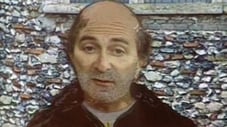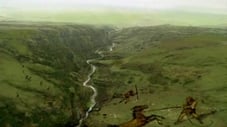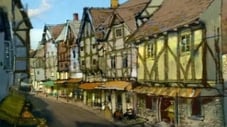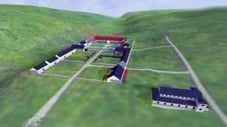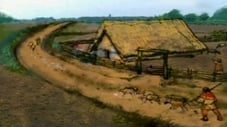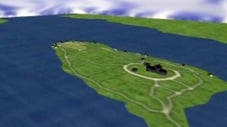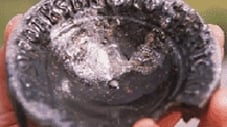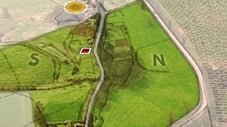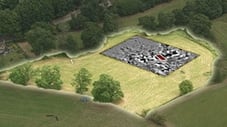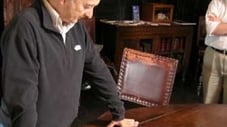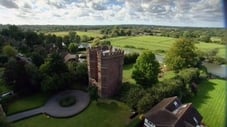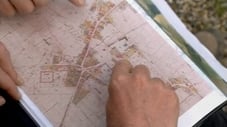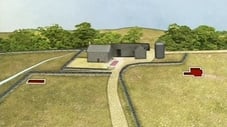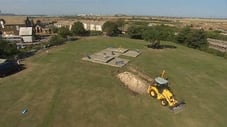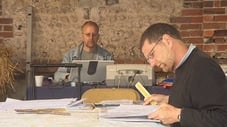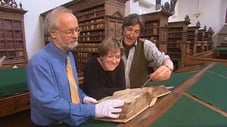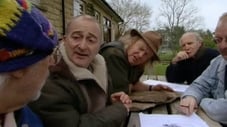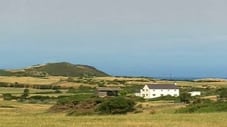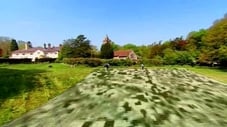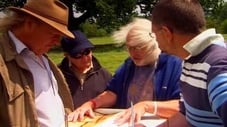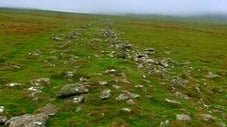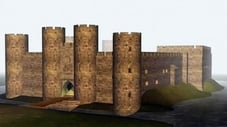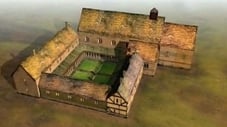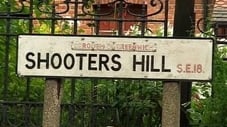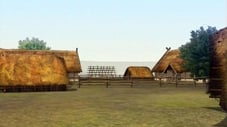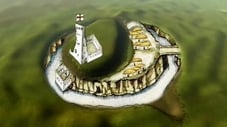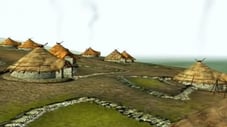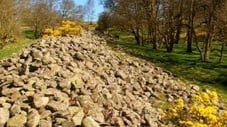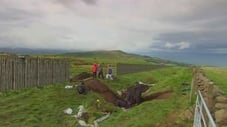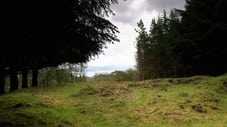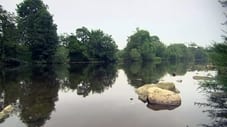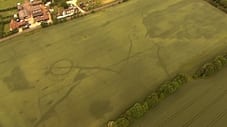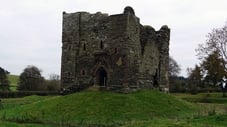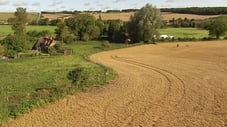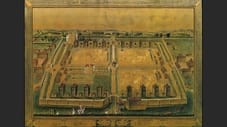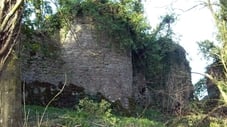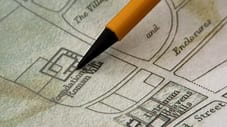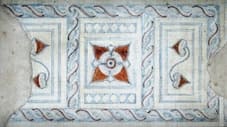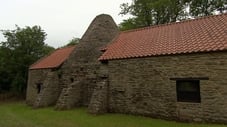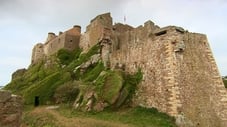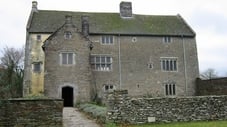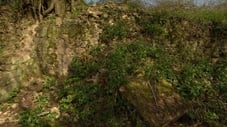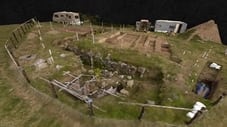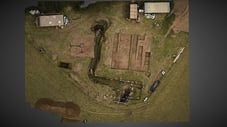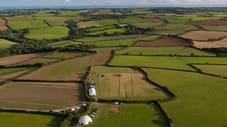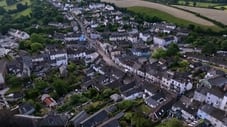
Time Team (1994)
← Back to main
Helen Geake as Self - Anglo-Saxon Specialist
Episodes 92
Wedgwood's First Factory - Burslem, Stoke-On-Trent
The Team are in Burslem, Stoke-on-Trent, to investigate what remains of Josiah Wedgwood's first factory and to discover what pottery he was making there. They find evidence of several centuries of potting and bottle kilns, including a time capsule of the pottery of Enoch Wood & Sons. Experimental archaeology: a replica creamware vase.
Read MoreBack Garden Roman Finds - Papcastle, Cumbria
The team are in North West England, investigating Roman finds and a possible Roman building, unearthed in a family's back garden. The house is just 100 metres from a Roman fort, and south-west of the end of Hadrian's Wall. Geophysics are using state-of-the art Swedish radar equipment, to detect foundations beneath two metres of soil. A fragment of bronze mirror hints at a domestic settlement, a vicus, that would have sprung up next to the fort. But the diggers are finding plenty of archaeology, indicating much larger and more organised Roman building, possibly a city. Through the expertise of potter Gilbert Burroughes, the team are going to try to make a Samian ware bowl during the three days. The team are joined by Roman specialist Lindsay Allason-Jones.
Read MoreDominican Friary Church and Norman Cathedral - Thetford, Norfolk
Time Team have been invited by pupils of Thetford Grammar School in Norfolk, to investigate the remains of a Dominican friary church and a 1,000-year-old Norman cathedral, in their playground. There is much interest from the pupils when the team excavate human bones. Ecclesiastical historian Janet Burton describes the origins of the Dominican Order. Stonemason Simon Williams gives a practical demonstration of medieval wall-building using knapped flint and lime mortar. Stained glass expert David King confirms medieval dates for fragments from the friary. The junior school makes a timeline frieze, complete with felt bishops and monks. It all ends in an open evening for parents.
Read MoreCooper's Hole - Cheddar Gorge, Somerset
Investigation, at the invitation of the cave's owner, the Marquess of Bath, to see if there is evidence of Palaeolithic human activity in the cave. This may be among the oldest homes in England. The ultimate aim is to get the site scheduled and thus protected from unofficial damage. However it soon becomes clear there is a lot of preparatory work involved. They are joined by palaeontologist Andy Currant, and cave archaeologists Larry Barham and Kate Robson Brown. Caver Malcolm Cotter directs them to a cache of bones; but the tunnel is blocked by sediment from flooding.
Read MoreMedieval Plympton - Plympton, Devon
In the 12th century many towns were designed and laid out on regular lines. The people of Plympton believe there is enough evidence to plot the layout of the medieval town which surrounds the ruins of their castle, and which was formerly owned by the immensely powerful and wealthy de Redvers family. As usual, Time Team have three days to find it. Back gardens and interiors will provide the clues, rather than frontages which have probably been altered many times in the last 800 years. So they will need plenty of help from local householders. They are joined by Plymouth city archaeologist Keith Ray and dendrochronologist Robert Howard.
Read MoreTudor Dockyard - Smallhythe, Kent
Looking for evidence of a 15th century dock, the team are in Small Hythe. The dock was once next to the mile-wide River Rother but its location is now an overgrown field, ten miles from the sea. And early excavations reveal nothing more recent than wood from a prehistoric forest. Medieval ship expert Ian Friel explains that the dockyard used to have high naval significance, and was visited by Henry V. Woodworker Damian Goodburn uses authentic tools to build a ship's clinker hull. Victor draws the biggest ship ever built here, the Jesus. Using geophysics, John Gater and Sue Ovenden pinpoint the course of the old river. And very soon the finds start to accumulate, revealing the true scale of activity here.
Read MoreGolf Course Roman Bathhouse - Beauport Park, Sussex
Historian Guy de la Bedoyere asks the team to investigate the isolated ruins of a bath-house, discovered by Gerald Brodribb in the midst of dense Sussex woodland. Gerald has made a scale model of the building, and Guy explains the connection to the Roman navy. After a demonstration of dowsing from Gerald, the team's first task is to clear the land before digging. With ancient technology expert Jake Keen and blacksmith Reg Miles, Phil attempts to smelt iron using a traditional furnace. The team are also joined by archaeometallurgist Gerry McDonnell.
Read MoreBombers In Reedham Marshes - Reedham, Norfolk
Time Team team up with air crash investigators to discover what happened to two B-17 bombers which crashed with loss of all lives on board on 21 February 1944 into marshes near Reedham, Norfolk. The airplanes were returning from a bombing raid on a German target as part of the Big Week offensive. Parts of one airplane are recovered, and the Team speak to surviving crew members of a third plane that was in the formation. Experimental archaeology: A piece of nose art painted as a memorial to the bomber crews, painted by a former Red Cross volunteer who had painted some during WWII.
Read MoreBack To Turkdean - Turkdean, Gloucestershire
Time Team revisit a live dig from 1997, where they found a large Roman complex in a Gloucestershire field. But at the same time, geophysics recorded evidence of more buildings. And so the team have returned to investigate a greatly expanded area. Almost immediately Phil uncovers some impressive looking archaeology. They decide to build a Roman altar with a special inscription. They are rejoined by Roman specialists David Neal and Lindsay Allason-Jones.
Read MoreField Cropmarks - Kemerton, Worcestershire
An aerial survey of a Worcestershire field has revealed cropmarks leading to substantial Bronze Age finds. But Iron Age remains also exist. Time Team tries to sort it out. Local schoolchildren help with a bit of fieldwalking; and Mick shows how cropmarks and posthole marks become visible in fields. Francis Pryor explains the difference between Bronze Age and Iron Age and describes life in a roundhouse. Also joining the team are archaeologist Malcolm Atkin and environmentalist Liz Pearson; while wood specialist Guy Apter gets the kids to help make a Bronze Age ard (plough).
Read MoreRuined Norman Church - Bawsey, Norfolk
This live dig centres on a ruined Norman church on a hill in Norfolk. This National Trust site promises to be the richest source of finds that Time Team have yet seen, with previous evidence of human occupation from most periods in antiquity. This requires several trenches, including the longest one that Time Team have ever dug. They start with some fieldwalking and metal detectoring, before digging in earnest. Among many finds are a bronze age arrow head, a medieval tiled floor, coins and several well-preserved skeletons. One skull shows clear evidence of having been brutally slaughtered by a swordsman on horseback. The team are joined by Helen Geake, Neil Holbrook, Andrew Rogerson, pottery expert Paul Blinkhorn, osteoarchaeologist Margaret Cox, and historian John Blair. Celebrities Sandi Toksvig and Hugh Fearnley-Whittingstall also drop in. Hugh and Victor help Saxon re-enactor Russell Scott to recreate a bronze artefact from scratch.
Read MoreMontravers Estate (Part 1) - Nevis, West Indies
Invited by historian David Small, the team are on the tiny Caribbean island of Nevis, for a six-day dig to uncover the history of sugar production and slavery here. They are investigating a particular plantation, Montravers Estate, now overgrown, originally owned by wealthy 18th century Bristolean John Prater Pinney. Robin visits Bristol University, researching the extensive documentation. Back on Nevis, pottery expert David Barker is shown pottery sherds, most of which he dates to the 1840s. Phil crosses to neighbouring St. Kitts, to help make sugar from sugar cane. Sugar would have been extracted in a mill operated by teams of oxen. Molasses, the byproduct of sugar processing, was fermented to make rum. In the jungle Stewart searches for a slave village. They are also joined by local historian David Rollinson.
Read MoreMontravers Estate (Part 2) - Nevis, West Indies
Invited by historian David Small, the team are on the tiny Caribbean island of Nevis, for a six-day dig to uncover the history of sugar production and slavery here. They are investigating a particular plantation, Montravers Estate, now overgrown, originally owned by wealthy 18th century Bristolean John Prater Pinney. Robin visits Bristol University, researching the extensive documentation. Back on Nevis, pottery expert David Barker is shown pottery sherds, most of which he dates to the 1840s. Phil crosses to neighbouring St. Kitts, to help make sugar from sugar cane. Sugar would have been extracted in a mill operated by teams of oxen. Molasses, the byproduct of sugar processing, was fermented to make rum. In the jungle Stewart searches for a slave village. They are also joined by local historian David Rollinson.
Read MoreThe Bodies in the Shed - Glendon, Northamptonshire
The Team is visiting Glendon Hall to unravel the mystery of the human skeletons found under an outbuilding. The team are joined by Richard Morriss (historic building consultant) and Glenn Foard (landscape archaeologist).
Read MoreVillas out of Molehills - Withington, Gloucestershire
When a colony of moles brings up pieces of mosaic floor in a Cotswold field, Tony Robinson and the team investigate whether the findings could be linked to a nearby Roman villa discovered almost 200 years ago. A local spring might give a clue to the true purpose of the building. The team are joined by local archaeologist Roger Box, and Roman specialists David Neal and Richard Reece.
Read MoreRubble at the Mill - Manchester
The team set to work uncovering Manchester's first cotton mill, built by one of the fathers of the Industrial Revolution, Richard Arkwright. Over three days the team uncover the remains of a complex factory and also signs of a revolutionary steam engine that was decades ahead of its time. The team are joined by Mike Nevell from Manchester University, and Jennifer Tann (technology historian).
Read MoreThe First Tudor Palace? - Esher, Surrey
The team visit Wayneflete Tower which is all that remains of a palace. Over three days they piece together the story of a site that evolved into one of the most stunning buildings of early Tudor times. They are joined by historic buildings expert Jonathan Foyle, John Guy (historian) and dendrochronologist Mick Worthington.
Read MoreThe Boat on the Rhine - A Roman Boat in Utrecht - Utrecht, The Netherlands
The team is invited by Dutch archaeologists to help rescue crucial evidence from a 35-metre-long barge that once sailed the Rhine. The team has one chance to investigate the boat before the bulldozers move in.They are joined by city archaeologists Erik Graafstal and Herre Wynia, Fleur Kemmers (coin specialist) and Jaap Morel (ship archaeologist). Together with wood specialists Damian Goodburn and Esther Jansma, Phil looks at a similar barge which has been preserved and exhibited.
Read MoreCourt of the Kentish King - Eastry, Kent
The team descends on the orchards of Kent to search for the lost Anglo-Saxon palace of Eastry, and discover two likely contenders. Over three days, they dig the longest trench in Time Team history.
Read MoreThe Monks' Manor - Brimham, Harrogate, North Yorkshire
The team travels to the Yorkshire Dales to meet Chris and Barbara Bradley on their farm to uncover the remains of a monastic grange - a medieval forerunner to the grand country house, with connections to nearby Fountains Abbey. Kerry Ely is the site supervisor, and the team are joined by Jonathan Clarke (buildings archaeologist) and Mark Newman from the National Trust. Matt is "volunteered" to lead the tough life of a medieval lay brother for 24 hours.
Read MoreCastle in the Round - Queensborough, Kent
The team investigate the remains of Queenborough Castle on the Isle of Sheppey, built by Edward III for Queen Philippa during the Hundred Years' War. The Time Team excavate the castle mound, and opinion is divided whether this unique circular structure was built for defence or as a royal bolthole from the plague. They are joined by archaeologist Oliver Creighton, medieval historian Sam Newton and architectural historian Jonathan Foyle.
Read MoreSussex Ups and Downs - Blackpatch, near Worthing, Sussex
The team travels to what could be a Neolithic settlement in the Sussex Downs. Initially discovered by John Pull in 1923, the site is littered with remains of 6000-year-old flint mines. But Pull claimed to have discovered a second site nearby, which has so far eluded other diggers. The team are joined by archaeologist Miles Russell, pottery expert Sue Hamilton and wood specialist Maisie Taylor. Neolithic lifestyle specialist Jacqui Wood makes some elderflower tea and threatens to make a new hat for Phil. Phil and Francis demonstrate the relative merits of mesolithic and neolithic axes.
Read MoreBirthplace of the Confessor - Islip, Oxfordshire
The team descends upon the sleepy Oxfordshire village of Islip, the birthplace of Edward the Confessor, for one of the most challenging and intriguing excavations of the series. They are joined by architectural historians Sam Newton and Jonathan Foyle. Helen and Sam visit Westminster Abbey to view original documents relating Edward to Islip.
Read MoreEarly Bath - Ffrith, Flintshire
The team descend on the village of Ffrith in North Wales to discover if it is built on the remains of a Roman mining town. The main street runs along the route of Offa's Dyke. The dig involves excavating two gardens and the playing field, but the team are frustrated in their attempts to find a Roman bath house. The team are joined by archaeologist Chris Martin and historian David Mason.
Read MoreThe Taxman's Tavern - Alfoldean, Horsham, Sussex
Time Team travel to Alfoldean in West Sussex to uncover a Roman mansio or stopping-place, and hence the story of the whole settlement. The dig takes place in ploughed fields on both sides of the A29, or what the Romans knew as Stane Street. But atrocious weather and the sheer scale of the site push the team's resources to the limits. They are joined by Roman Sussex specialist Miles Russell and archaeologist Mike Luke. Phil gets a new hat. They are visited by pupils from the nearby Christ's Hospital School. Farrier Cliff Barnes uses the school forge to make hipposandals - precursors of the modern horseshoe.
Read MoreScotch Broch - Applecross near Skye, Scottish Highlands
Tony and the team journey to Applecross in the north west of Scotland to excavate a broch, a monumental dry-stone tower that was one of the largest Iron Age structures in Britain. But they are hampered by stony soil and a massive overhead power line. They are joined by Scottish Iron Age specialists Ian Armit, Andy Heald, Cathy Dagg, Noel Fojut.
Read MoreFinds on the Fairway - Isle of Man
The team battle the tail end of Hurricane Gordon to investigate the last keeill standing, preserved beneath a golf course on the Isle of Man. A thousand years ago the island was dotted with these keeills, or small stone chapels, most of which have completely disappeared. Mick, an avowed enthusiast for early Christian buildings, is in his element. Sensational finds keep coming, including perfectly preserved plaited human hair, and a specimen of Ogham script. The team are joined by local archaeologist Andy Johnson, keeill expert Nick Johnson, and Viking specialist Dawn Hadley
Read MoreThere's No Place Like Rome - Blacklands, near Frome, Somerset
The team are in Somerset to investigate the remains of a small Roman villa, dating back to just after the time of the Roman invasion in 43 AD. But previous excavations suggest it was occupied by local inhabitants rather than Roman invaders. Could it have been built on the site of an earlier, Iron Age settlement? The team are joined by Roman specialists John Creighton and Tom Moore; and Claire Ryley makes an authentic period garden. Members of the Stranglers put in a surprise appearance.
Read MoreSchool Diggers Medieval - Hooke Court, Dorset
The team are in Hooke Court, Dorset to investigate a moated manor house with a mysterious past. Now used as a school, the grounds contain remains of buildings from the past 500 years and as the trenchers begin their work, the finds start to pile up. Though they are particularly looking for evidence of the Civil War, there are signs of activity from several different periods, including medieval and Tudor. The team are joined by historians Sam Newton and Jonathan Foyle. The school's pupils get involved in all aspects of the dig. As usual, Stewart has his own ideas about the site, and is skeptical about the idea of a moat.
Read MoreThe Druids' Last Stand - Amlwch, Anglesey
Time Team are in the Island of Anglesey in North Wales, investigating a system of earthworks, not noticed until 2006 when identified by a light aircraft. Is it Iron Age or Roman? Though the locals believe that the ancient sect of the Druids was active in this area, the team are struggling to find anything that has not been ploughed away. But towards the end of the dig they make a completely unexpected find. The team are joined by Ken Brassil of the National Museum Wales. Using traditional techniques, local archaeologists make a wicker man, with a strange resemblance to a member of the team.
Read MoreSharpe's Redoubt - Sandgate, Kent
The team investigate the remains of Shorncliffe Redoubt, the first fort built to defend the English south coast from invasion by revolutionary French forces in the 1790s.
Read MoreA Port and Stilton - Stilton, Cambridgeshire
The team visit a site near the Roman road of Ermine Street, where a clutch of Roman objects has been discovered. But field-walking has also produced Anglo-Saxon artefacts, and it becomes apparent that the site had more historical activity than first anticipated. Unlike today, the terrain would have been largely boggy and marshy. The archaeology increasingly points to a Roman industrial site with strong evidence of pottery manufacture and export. But after the Romans left, it may have taken on an important monastic role - much to Mick's delight. The team attempt to reproduce a Roman kiln. Finally, towards the end of day three, John's geophysics uncovers a possible neolithic enclosure. They even find time for cheese tasting, though Stilton is not actually the place where Stilton cheese is made. They are joined by Philippa Walton from the PAS, and Ben Robinson of Peterborough Museum.
Read MoreA Tale of Two Villages - Wicken, Northamptonshire
The team descend on the village of Wicken to investigate the local history. Digging in residents' gardens and surrounding fields, the team uncover a mysterious church, an ancient burial ground and evidence of a Saxon community.
Read MorePugin - The God of Gothic
Tony Robinson talks us through the renovation of, perhaps, one of the most important homes ever built: Augustus Pugin's home in Ramsgate. In the mid-19th century, Pugin reinvented a medieval style of architecture that became known as Gothic Revival. Best known for his work on the Houses of Parliament, he built the Grange in Ramsgate in the 1840s using his own money and with, as he put it, "not an untrue bolt or joint from foundation to flagpole". Amazingly, the house was about to be destroyed in 2004 when the Landmark Trust set about restoring it. Time Team follows the transformation of the property and visits other Pugin creations around the country. It promises to be an intriguing mix of Grand Designs and Restoration - what could be better?
Read MoreNo Stone Unturned - Warburton, Greater Manchester
The team arrive at a field outside Cheshire where metal detectorists have made several valuable finds in the past, hinting the site was once a very active Roman settlement. However, the complete lack of finds causes serious concern amongst our intrepid explorers. They are joined by Mike Nevell from the University of Manchester, Roman historian David Shotter, and Robert Philpott from Liverpool Museum. Archeometallurgist Andrew Lacey fashions a simple Roman snake bracelet. Famously, this is the episode where Tony declares "We've done what we always threatened: after 160 programmes, we found - nothing."
Read MoreThe Domesday Mill - Dotton, Devon
Time Team have never excavated a watermill before. Despite the fact that they were plentiful in historic times, these features have been under-researched. Heading to the River Otter in Devon, the team excavate a site dating back at least to the Domesday Book of 1086, yet the last mill building on the site was pulled down as recently as the 1960s. They are joined by Martin Watts (mill historian), industrial archaeologist Mike Nevell, and Finds specialist John Allan. Tony visits the working mill at nearby Otterton.
Read MoreThe Cheyne Gang - Chesham Bois, Buckinghamshire
Archaeologists in Chesham in Buckinghamshire believe they've found the remains of a medieval building under the manicured lawns of a Georgian house.
Read MoreRoad to the Relics - Godstone, Surrey
A local metal detectorist has been visiting the same field in Godstone in Surrey for the past 15 years, and in that time has discovered a huge collection of Roman finds. Around 600 coins, many of them of high value, have been recovered from the field, as well as a collection of brooches and other more unusual items, including what looks like a metal sceptre handle. Local archaeologists believe that the number and value of the finds means that they may have been deliberate offerings, pointing towards a possible Roman temple or religious site. The possible sceptre handle is similar to ones that have been found at another Roman religious site nearby and may have been used by priests. The site is positioned close to a Roman road connecting London to the south coast and has never been excavated, although English Heritage did commission a geophysics survey. Local archaeologists have been wondering what lies beneath the surface for many years, and called in Time Team to help them find out.
Read MoreThe Abbey Habit - Poulton, Cheshire
Tony Robinson and the team travel to the Welsh border in search of the abandoned Poulton Abbey that was once briefly used by Cistercian monks. Mick is delighted to be researching his favourite subject, monastic history. Though local archaeologists have found a chapel and plenty of other remains (including skeletons), there is no sign of the abbey. As the hunt drags on without any major progress, some of the team come up with a controversial theory. The team are joined by Mike Emery and Alan Wilmshurst from the Poulton Research Project, architectural historian Jonathan Clark, local historian Alan Thacker, and Finds specialist Debbie Klemperer.
Read MoreIn the Shadow of the Tor - Bodmin Moor, Cornwall
The Team descend on the bleak, beautiful landscape of Bodmin Moor to face one their biggest challenges yet. The dig aims to date a possible Bronze Age village of stone houses. But alongside the village is a vast and mysterious 500-metre-long stone structure. The team are joined by Peter Herring of Cornwall Heritage Trust and environmental archaeologist Ben Gearey.
Read MoreGold in the Moat - Codnor Castle, Derbyshire
The crumbling ruins of Codnor Castle are a sad remnant of the imposing home of the De Grey family - knights who saw action in almost every important medieval battle including the crusades and Agincourt. Today Codnor Castle lies in ruins and there's almost nothing known of how it looked in its prime. As the remains above ground get an overdue renovation, the Time Team risk the dangers of hidden mine shafts in the Derbyshire coalfields to dig into the heart of a building that once dominated the landscape to trace the castle's history. It lives up to the team's hopes as they strike gold with a 600-year-old gold noble coin as well as uncovering a huge round tower and, for the first time in the history of the programme, a drawbridge.
Read MoreStreet of the Dead - Binchester, County Durham
Tony and the team tackle a huge Roman fort in County Durham. The stronghold was part of the defence of Dere Street, the main Roman road from York to Hadrian's Wall. The fort has fine mosaics and preserved rooms, but the Team have just three days to find out everything they can about the 'vicus', that's the civilian settlement around the fort, vital for the smooth running of the military machine and providing for the pleasures of the men garrisoned there. However, they soon discover something even more exciting during the dig - a series of military mausoleums, the first discovery of its kind for over 150 years. They also discover the remains of food eaten by the descendants of the dead during ritual meals.
Read MoreBodies in the Dunes - Barra, Western Isles
The Team travel to the windswept island of Barra, 50 miles off the west coast of Scotland, for a unique rescue dig. This Hebridean outpost is famous for its strip of unusually fertile sand dunes all round the coast, land that has been home to settlers for the last 4,000 years. When a storm ripped apart one of the dunes, it revealed Bronze Age graves and the remains of ancient houses. The team must also work in the face of the fierce Barra winds to preserve a collection of Iron Age ornaments before they become lost forever, including the remains of a cooking pot, and tools crafted from animal bones and whale rib.
Read MoreThe Naughty Nuns of Northampton - Towcester, Northamptonshire
A Northampton family, the Colecloughs live on the site of a 900-year old nunnery with a rather fruity past, which was at various times accused of witchcraft, begging and debauchery.
The burial of a much loved family pet provides the curious starting point for an investigation. When eight-year-old Amy Coleclough's cat "Paintpot" died and her father dug a grave, he uncovered a large old wall. So Tony and the team dig up their garden, including a mysterious sarcophagi hidden there.
Read MoreMysteries of the Mosaic - Coberley, Gloucestershire
Tony Robinson and his team unearth the secrets of a Cotswolds field. Hundreds of Roman coins and bits of masonry have been found on this land but it's the chance discovery of a piece of mosaic floor that has really got the archaeologists excited. The great and the good of Roman Britain built their posh houses in the Cotswolds, a sort of ancient stockbroker belt.
Read MoreBlitzkreig on Shooter’s Hill - South London
The Team delve into the very recent past to uncover the hidden archaeology of the biggest British battle that never was: the defence of Britain against a Nazi invasion in 1940. Along the busy main roads and in the quiet back gardens of a London suburb they uncover evidence of anti-tank weapons, secret bunkers and massive flame throwers.
Read MoreKeeping Up with the Georgians - Hunstrete, Somerset
The team descend on a field just outside Bath to investigate the remains of what could have been one of the country's grandest Georgian houses. An impressive set of stone arches is all that remains of the house built 200 years ago by local MP Sir Francis Popham, but a couple of paintings show the building in its prime.
Read MoreSaxons on the Edge - Stonton Wyville, Leicestershire
An unassuming field in Leicestershire provides the team with a prize that has eluded them for 15 years. In a first for the programme, Tony Robinson and the team finally uncover the rarest of archaeological finds: an Anglo Saxon settlement and, in an attempt to discover the true origin of Britain's most famous Wessex Man, Phil Harding undergoes a DNA test to establish where his ancestors came from.
Read MoreFort of the Earls - Dungannon, Northern Ireland
The team visit Northern Ireland to locate one of the most important sites in Anglo-Irish history. A hilltop castle above the city of Dungannon, stronghold of the powerful O' Neill clan, was seized by English forces in 1602, setting off events that would cause unrest in the two countries for centuries to come, the same hill was a top secret British Army base for the last 50 years.
Read MoreFrom Constantinople To Cornwall - Padstow, North Cornwall
Cornwall is probably not the first place that springs to mind when thinking about the Roman and Byzantine Empires but in a field overlooking a cove, just a mile down river from the famous Cornish village of Padstow, locals have picked up a wealth of 1,500-year-old pottery and metalwork from as far away as North Africa and Turkey. Geophysics results suggest an Iron Age village may have once been located on the site, but archaeologists think the cove may have also been a port for Mediterranean traders. The team dig for evidence which will support the theory, and after three days of work and initial difficulties, they believe they know how the site looked in its prime.
Read MoreFive Thousand Tons of Stone - Hamsterley, County Durham
The Time Team travel to County Durham to investigate the origins of a mysterious large stone structure which has had locals baffled for centuries. The stone structure is known locally as The Castles, its five-metre thick walls enclose a space the size of a football pitch.With guesses ranging from an Iron Age farm to a Roman prison, Tony Robinson and the team attempt to come up with a definitive answer.
Read MoreThe Romans Recycle - Wickenby, Lincolnshire
Tony Robinson and his intrepid team of archaeologists head off the beaten track in Lincolnshire to discover why a metal detector enthusiast has discovered hundreds of Roman and Iron Age artefacts in a muddy field. Add to that the mysterious Roman columns strewn around the surrounding village and the team have a challenging three days to come up with some answers. As the dig progresses, the evidence mounts to suggest that the local Roman population were conscious of the need to recycle.
Read MoreHunting King Harold - Portskewett, South Wales
For the final episode of the 2008 series the team head to the village of Portskewett in South Wales to investigate a field which is intriguingly named Harold's Field. Local legend has it that King Harold built a hunting lodge there the year before he lost the Battle of Hastings. The field is a mass of big earthworks and historical documents do record Harold building a lodge somewhere round the village of Portskewett. Within minutes of digging, the team discover that the site was not confined to just Harold and the Saxon period, having been used since late Roman times until well into the Middle Ages.
Read MoreThe Trouble with Temples - Friars Wash, Hertfordshire
Time Team has never found a Roman temple. But a 30-year-old photograph clearly shows double square cropmarks in a field. Surely this time they will strike lucky? The trouble is, the site may have suffered plough damage. Francis takes charge. Though initial excavations are encouraging, John and Stewart are puzzled by a geophysical anomaly. Including a tessellated pavement and a coin hoard, a picture gradually emerges of not one but four temples - in fact a whole complex of buildings. It proves to be one of the most important excavations in Time Team history.
Read MoreThe Wedding Present - Scargill Castle, County Durham
The Team pieces together the history and the layout of a very special wedding present – Scargill Castle, in the remote wilds of County Durham.
Read MoreHeroes’ Hill - Knockdhu, County Antrim
Working with archaeologists from Queen's University in Belfast, the Team takes up the challenge to unlock the prehistoric secrets of the headland at Knockdhu, County Antrim.
Read MoreToga Town - Caerwent, South Wales
Caerwent is the best-preserved Roman town in Britain. Laid out on a grid pattern, it has 20 blocks within its walls, which still stand at heights of up to five metres in places. Previous excavations have uncovered roads, temples, shops, baths, houses and villas, as well as the forum and basilica, the town's political centre.
Read MoreBlood, Sweat and Beers - Rise Hill, Cumbria
Time Team visits the Yorkshire Dales to investigate the Risehill camp settlement, inhabited by the Victorian railway navvies during the construction of the Settle-to-Carlisle railway. On a wind- and rain-swept Yorkshire moor – 'the most exposed site Time Team has ever dug on,' according to Tony Robinson – lie the remains of a settlement built by a tough, nomadic community that existed on the very edge of society.
Read MoreBuried Bishops and Belfries - Salisbury Cathedral, Wiltshire
Time Team gets a once-in-a-lifetime opportunity to dig in the hallowed grounds of Salisbury Cathedral – in Phil Harding's home town. In 2008, Salisbury marked the 750th anniversary of the consecration of its cathedral. At the end of September the city played host to Time Team, who had been given the unique opportunity to investigate some of the lost architectural treasures of this magnificent building.
Read MoreAnarchy in the UK - Radcot, Oxfordshire
The Team are in Radcot, Oxfordshire, where they hope to uncover a long-lost fortress built in the 12th century during one of the bloodiest episodes of English history.
The tiny hamlet of Radcot in Oxfordshire stands on a strategic crossing on the river Thames. Competing armies have fought over control of the crossing from at least medieval times through to the English Civil War.
Read MoreMystery of the Ice Cream Villa - Colworth, Bedfordshire
The Team are invited to investigate a Bedfordshire field by a group of amateur archaeologists who have found countless pieces of Roman pottery, coins and building material over the years.
In a field next to a science park in Colworth, Bedfordshire, a group of amateur archaeologists have turned up a huge collection of material dating back almost 2,000 years.
Read MoreHermit Harbour - Looe, Cornwall
Legend has it that Jesus Christ himself played on the pebble beach at Looe Island (also known as St George's Island), about one mile off the south Cornwall coast near Looe. It is a story that probably originated when the island was being established as a place of pilgrimage to rival St Michael's Mount further to the southwest.
Read MoreCalled to the Bar - Lincoln’s Inn, London
The Team visits Lincoln's Inn, London where they have been asked to investigate the remains of a 13th-century palace that belonged to Henry III's Lord Chancellor. There were only a few areas within Lincoln's Inn where any excavation could take place. As well as it not being possible to dig under the other historic buildings, a huge London plane tree precluded any excavation that would threaten its root system.
Read MoreBeacon on the Fens - Chapel Head, Cambridgeshire
Over the years, farmers working the fields have found large quantities of worked stone, medieval tiles and even two shelly limestone columns, adding credence to the local belief that a medieval chapel once stood here. Time Team visits the cold and windswept Chapel Head, in the Cambridgeshire Fens, to see if a medieval chapel did once stand there.
Read MoreThe Hollow Way - Ulnaby, County Durham
Time Team sets out to unearth the secrets of the deserted medieval village of Ulnaby in Durham. The challenge was to tell the story of a whole lost village – a once-thriving rural world
Read MoreSkeletons in the Shed - Blythburgh, Suffolk
Tony Robinson and the Team travel to the picturesque expanses of the Suffolk coast to investigate a very special back garden. When the new owners of a house in Blythburgh explored their potting shed they were shocked to discover a cupboard full of human skulls.
Read MoreCorridors of Power - Westminster Abbey, London
In the first episode of the new series, Tony Robinson, Professor Mick Aston and the Team investigate one of Britain's greatest historic landmarks: Westminster Abbey. Surrounded by the sights and sounds of Parliament Square, the archaeologists have three days to pin down the location of a lost sacristy, a stronghold that was built by Henry III almost 800 years ago and is said to have housed the biggest collection of treasure this side of the Alps. Under the watchful eye of the Abbey's clergy and numerous tourists, the diggers' attempts to find this important building are continually thwarted by the driving London rain and centuries of later building work.
Read MoreA Saintly Site - Isle of Mull, Inner Hebrides
Time Team descend on the Isle of Mull at the invitation of two local amateur archaeologists to investigate a mysterious set of earthworks in a forest near Tobermory. Could they be the remains of a chapel from the time of St Columba?
Read MoreBridge over the River Tees - Piercebridge, County Durham
Tony Robinson and the Team get their feet wet as they examine a stretch of the River Tees where local divers have discovered more than 2,000 high-quality Roman finds. The river flows past one of the most impressive Roman forts in northern Britain, and over three days the archaeologists cast their net far and wide investigating the buildings, roads and structures around this strategic crossing. However, the big challenge is working out what was going on in the middle of the river, where most of the finds came from, and that means a variety of Time Team's finest squeezing into wetsuits and braving the fast flowing river Tees.
Read MoreIn the Halls of a Saxon King - Drayton, Oxfordshire
In Sutton Courtenay Tony Robinson and the Team investigate a set of buildings once occupied by Anglo Saxon royalty. It's the rarest of archaeological sites and uncovers the biggest Saxon building ever discovered in Britain. Aerial photography of an apparently featureless Oxfordshire field revealed crop marks that suggested to archaeologists it was once the site of an impressive collection of 1,400-year-old buildings; but Time Team's digging expertise was needed to verify this. The trenches are big and the archaeology complicated but slowly the Team begin to build up a picture of life here over 1,000 years ago, with the help of heroic Saxon poetry. As well as stunning finds and the perplexing possibility that they have uncovered an Anglo Saxon totem pole, the archaeologists also discover a culture where heroism, story telling and drinking go hand in hand, and learn the finer points of how to insult your colleagues in Old English.
Read MoreThe Massacre in the Cellar - Hopton Castle, Shropshire
Tony Robinson and the Team visit the remains of Hopton Castle in Shropshire. Although it's picturesque, it was the site of a series of gruesome battles that took place at height of the English Civil War, when a Royalist force laid siege to a small garrison of Parliamentarians inside the castle. The Team use contemporary accounts and the evidence from their own trenches to separate fact from propaganda and piece together a blow-by-blow account of these violent days in 1644. The dig immediately produces evidence of battle. Over three days the archaeology begins to build up a compelling story of how the defenders fought off two attacks, killing hundreds of Royalists, before finally succumbing to the greater numbers of their enemy.
Read MorePotted History - Mildenhall, Wiltshire
Time Team visits the heart of Wiltshire for one of their most ambitious projects ever: to investigate an entire lost Roman town. Hidden under acres of wheat, Cunetio would once have been a bustling market centre. It's also the place where Britain's largest ever coin hoard was found. In the 1970s a pot containing 55,000 Roman coins was discovered, and one of the archaeologists called in to deal with it was Time Team's own Phil Harding. Now, 30 years later, he's back to dig this massive site and to find out how much effort is required to bury 55,000 coins. Over the three days, the scale of the site pushes the Team to the limit. Hampered by driving rain, the archaeologists battle to make sense of trenches that contain hundreds of years' worth of archaeology, while the geophysics team make almost half a million readings to complete the biggest survey ever recorded on Time Team.
Read MoreDeath and Dominoes: The First POW Camp - Norman Cross, Cambridgeshire
The Team visit Norman Cross in Cambridgeshire, a site that is over 200 years old and housed the world's first ever purpose-built prisoner of war camp. It has never before been excavated and the team are keen to unearth the final resting place of almost 2,000 prisoners who died at the camp, but what they discover takes them all by surprise.
Read MoreSomething for the Weekend - Tregruk Castle, Llangybi, Monmouthshire
Tony Robinson and the Team find themselves lost in the mists of a Welsh forest as they investigate one of the biggest castles in Britain. Their task is to investigate the castle's mysterious interior and find out how this impressive structure fitted into a network of fortresses built by powerful English barons 700 years ago.
Read MoreGovernor's Green - Governor's Green, Portsmouth
The Team visit Portsmouth to try and uncover one of the city's oldest buildings - a medieval hospital. But after three days of bone-chilling weather and confusing archaeology can the Team work out what stood on Governors Green over 500 years ago?
Read MorePriory Engagement - Burford, Oxfordshire
The Team descend upon the Oxfordshire town of Burford to respond to very special challenge - from Time Team's own Professor Mick Aston. They have just three days to uncover a medieval hospital under the front lawn whilst searching for Anglo Saxons in the vegetable garden.
Read MoreThere's a Villa Here Somewhere - Litlington, Cambridgeshire
But has 18th-century quarrying destroyed all meaningful evidence? Ben Robinson supervises this dig in the absence of Mick Aston. The end results are shown to the appreciative villagers.
Read MoreCommanding Heights - Dinmore Hill, Herefordshire
Tony and the Time Team climb a remote Herefordshire hill to investigate one of the biggest prehistoric sites ever featured. Was Dinmore Hill the site of a vast Iron Age hill fort? Needless to say Stewart doesn't think so. He is going with a much earlier cross-ridge dyke. To prove it one way or the other they need dateable finds. But the dig is hampered by torrential rain. Despite this they uncover a huge, magnificent ditch, which must have been dug by thousands of people during the Iron Age. The team are joined by historian Bettany Hughes, Hereford county archaeologist Keith Ray and environmental archaeologist Mike Allen.
Read MoreReservoir Rituals - Tottiford Reservoir, Devon
Tony Robinson and his team celebrate their 200th dig. Jane Marchand from Dartmoor National Park Authority was alerted by a walker to standing stones peering out of an East Devon reservoir at low level. This is Francis Pryor's dream site, but Mick has also been interested in Dartmoor for some time. They have stone circles, stone rows and cairns apparently dating from 3000 to 1500 BC. There is a central mound which interests Francis, and which Phil thinks is Stone Age, thus pre-dating the other monuments. But the cairns may be recent, throwing into doubt the dating of the other features. This is cultivated farmland, atypical of Dartmoor's usual bleak landscapes. John is dubious about getting any meaningful geophysics results, but proposes nevertheless to wheel his trolley through the mud. Stewart and Henry create a 3D image of the prehistoric landscape. Phil teaches Matt his favourite activity, flint-knapping.
Read MoreSaxon Death, Saxon Gold - West Langton, Leicestershire
The Team are intrigued by metal detecting finds and pottery scattered across some fields in Leicestershire, which suggest they're on the site of a high-status Anglo-Saxon burial ground.
Read MoreRomans on the Range - High Ham, Somerset
Tony and the Team get a unique opportunity to dig at an army firing range at High Ham in Somerset and investigate a series of mosaics first discovered 150 years ago. Everything indicates a Roman villa, though perhaps not on such a grand scale. The inhabitants may have been Romanised Britons, living from the 2nd to the early 5th century. Matt volunteers as a slave for the day. When the cold east wind sets in, Phil and the other diggers temporarily "down tools". They are joined by Martin Brown from the Defence Estates and Roman finds specialist Philippa Walton.
Read MoreHitler's Island Fortress - Les Gellettes, Jersey
Tony Robinson doesn't usually get to decide where the Team should dig, but in this episode he chooses his first ever site for investigation: a German anti-aircraft battery on Jersey. The dig director was Dr. Ben Robinson.
Read MoreFurnace in the Forest - Derwentcote, County Durham
Dense and tranquil woodland in the County Durham countryside provides an unlikely venue for Time Team's investigation into the earliest days of the Industrial Revolution.
Read MoreUnder the Gravestones - Castor, Cambridgeshire
The Team face one of their strangest challenges ever: digging through a church graveyard in search of what could be one of the largest Roman structures ever built in Britain.
Read MoreHouse of the White Queen - Groby, Leicestershire
Tony and the Team discover evidence of a dynasty that arrived with William the Conqueror and went on to produce two queens of England: Elizabeth I and Lady Jane Grey.
Read MoreCannons and Castles - Mont Orgueil, Jersey
Tony Robinson heads to Jersey to investigate the origins of Mont Orgueil Castle. Today's castle is a Tudor structure built on earlier foundations, and it's that early castle, built by King John, that the Team are looking for.
Read MoreMystery of the Manor Moat - Llancaiach Fawr, South Wales
Investigating an archaeologist's dream. An ancient moat has been discovered and no one knows what it once protected. Was it an early Welsh chapel, a Roman fort, a fortified cattle enclosure, or even the ancestral home of one of Wales's most important families?
Read MoreBuck Mill, Somerset - Search for the Domesday Mill
When Stephen and Stephanie Fry bought a few acres of prime Somerset pasture to graze their horses, they inadvertently also bought the remains of Buck Mill, an 18th-century water mill. But as Stephanie began to look into its history, she realised that there may have been a flour mill on the site since Domesday. So she called in Tony Robinson and the Team to help her unravel the mystery of their mill. For Professor Mick Aston, the prospect was too good to turn down. As the diggers get to work uncovering the whole of the 18th-century mill, Mick takes off into the landscape to look for clues from earlier centuries. He finds more than he bargained for: the whole area was awash with the tell-tale mill streams needed to power grindstones. The dig throws up constant reminders of the importance of wheat and bread to the medieval population, and of how rich millers could become. The only spanner in the works for this industrial dig is the surprise discovery of an Anglo Saxon comb.
Read MoreRooting for the Romans - Bedford Purlieus Wood, Cambridgeshire
An eagle-eyed forest ranger spotted bits of Roman building poking out from the forest floor in Cambridgeshire's Bedford Purlieus Wood.
Read MoreCornwall: Day One
Time Team officially returns for its first brand new episode in a decade. New presenters Dr Gus Casely-Hayford and Natalie Haynes join team members old and new to investigate an Iron Age settlement in Cornwall with mysterious underground passages, known as a fogou.
Armed with new technology, and with help from Site Director James Gossip and the Meneage Archaeology Group, Time Team have just three days to shed light on this fascinating prehistoric site on the Lizard Peninsula. Can they do it?
Read MoreCornwall: Day Two
The team's investigation into the Iron Age settlement continues and Natalie tries her hand at making some Bronze Age pottery.
Read MoreCornwall: Day Three
The final day of the Cornish dig and will the team be able to resolve whether they've found a barrow or some other structure? Elsewhere, there is news about Helen's coin and some exciting finds in Matt's Bronze Age roundhouse.
Read MoreOxfordshire: Day One
Time Team continues with its second brand new excavation in a decade. New presenters Dr Gus Casely-Hayford and Natalie Haynes join team members old and new to investigate a huge Roman villa on the estate of Broughton Castle in Oxfordshire.
Armed with new technology, and with seasoned Site Director Neil Holbrook back at the helm, Time Team have just three days to shed light on this complex site.
Read MoreOxfordshire: Day Two
Day Two, Matt extends Trench One in hopes of finding the north-west corner of the Roman villa, while the radar results reveal a significant structure in the south-east end.
Read MoreOxfordshire: Day Three
The final day of the dig and the team re-investigate the stone sarcophagus first discovered in the 1960s. Elsewhere on the site, the trench containing the horse's head unearthed on Day Two is expanded.
Read MoreKnights Hospitaller Preceptory: Day One
Time Team are at Halston Hall, Shropshire, where Stewart Ainsworth believes he's found a lost Knights Hospitaller preceptory. Is Stewart right? The team have just three days to find out!
Read MoreKnights Hospitaller Preceptory: Day Two
It's Day 2 at Halston Hall, Shropshire, where Time Team are trying to locate a possible Knights Hospitaller preceptory.
Read MoreKnights Hospitaller Preceptory: Day Three
It's the final day at Halston Hall, Shropshire, where Time Team are trying to locate a possible Knights Hospitaller preceptory. Can we make sense of another complex site? Join us to find out!
Read MoreAnglo-Saxon Cemetery: Day One
Time Team have been called in by Dr Helen Geake to investigate the site of an early Medieval burial in Norfolk that has unearthed some incredible finds. Can the team relocate the grave and is it the site of a larger cemetery? We have just three days to find out!
Read MoreAnglo-Saxon Cemetery: Day Two
It's Day 2 in Norfolk, and Time Team have been called in by Dr Helen Geake to investigate the site of an early Medieval burial that has unearthed some incredible finds. Can the team relocate the grave and is it the site of a larger cemetery? We have just three days to find out!
Read MoreAnglo-Saxon Cemetery: Day Three
It's our final day in Norfolk, where Time Team have been called in by Dr Helen Geake to investigate the site of an early Medieval burial that has unearthed some incredible finds. Can the team make sense of this intriguing site? We have just one day left to find out!
Read MoreModbury Community Dig: Day One
Time Team joins forces with the people of Modbury to uncover their dramatic history. They hunt for clues throughout the town, in attics in living rooms, and under brand new lawns. The team look for for evidence of Civil Wars that raged through the town in the 17th century.
Time Team are joined by Jim Stetson, whose family sat at the heart of the community before they left for America to find their fortune making hats. Will they piece together the dramatic ups and downs of Modbury and its fascinating history?
They have just three days to do it!
Read MoreModbury Community Dig: Day Two
Time Team joins forces with the people of Modbury to uncover their dramatic history. They hunt for clues throughout the town, in attics in living rooms, and under brand new lawns. They're looking for for evidence of Civil Wars that raged through the town in the 17th century.
Time Team are joined by Jim Stetson, whose family sat at the heart of the community before they left for America to find their fortune making hats. But will they piece together the dramatic ups and downs of Modbury and its fascinating history? They have just two days left to do it!
Read MoreModbury Community Dig: Day Three
Time Team joins forces with the people of Modbury to uncover their dramatic history. They hunt for clues throughout the town, in attics in living rooms, and under brand new lawns. The team look for for evidence of Civil Wars that raged through the town in the 17th century. Time Team are joined by Jim Stetson, whose family sat at the heart of the community before they left for America to find their fortune making hats. Will they piece together the dramatic ups and downs of Modbury and its fascinating history? They have just one day to do it!
Read More

